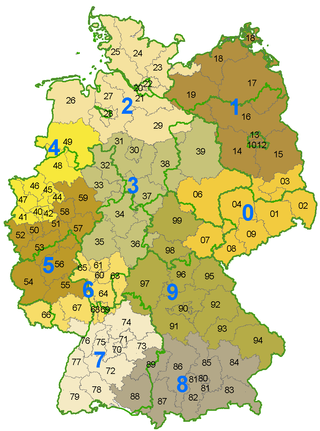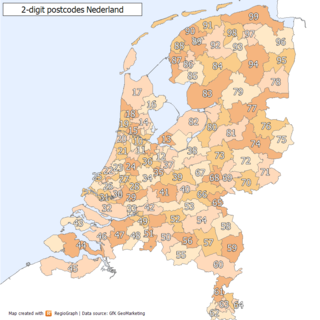
Postal codes in Armenia consist of four digits. Until 1 April 2006, postal codes consisted of six digits. For example, the previous postal code for the Foreign Ministry was Yerevan 375010 and is now Yerevan 0010.

Postal codes in Armenia consist of four digits. Until 1 April 2006, postal codes consisted of six digits. For example, the previous postal code for the Foreign Ministry was Yerevan 375010 and is now Yerevan 0010.

A postal code is a series of letters or digits or both, sometimes including spaces or punctuation, included in a postal address for the purpose of sorting mail.

A ZIP Code is a system of postal codes used by the United States Postal Service (USPS). Introduced on July 1, 1963, the basic format consisted of five digits. In 1983, an extended ZIP+4 code was introduced; it included the five digits of the ZIP Code, followed by a hyphen and four digits that designated a more specific location.

Postal codes used in the United Kingdom, British Overseas Territories and Crown dependencies are known as postcodes. They are alphanumeric and were adopted nationally between 11 October 1959 and 1974, having been devised by the General Post Office. A full postcode is known as a "postcode unit" and designates an area with several addresses or a single major delivery point.
Postal codes were introduced in South Africa on 8 October 1973, with the introduction of automated sorting.
Postal codes were introduced in France in 1964, when La Poste introduced automated sorting. They were updated to use the current 5 digit system in 1972.
Spanish postal codes were introduced on 1 July 1984, when the Sociedad Estatal de Correos y Telégrafos introduced automated mail sorting. They consist of five numerical digits, where the first two digits, ranging 01 to 52, correspond either to one of the 50 provinces of Spain or to one of the two autonomous cities on the African coast.

Zvartnots International Airport is located near Zvartnots, 15 km (9.3 mi) west of Yerevan, the capital city of Armenia. It acts as the main international airport of Armenia and is Yerevan's main international transport hub. It is the busiest airport in the country.
Postal codes in Argentina are called códigos postales. Until 1998 Argentina employed a four-digit postal code for each municipality, with the first digit representing a region in the country, except in the case of the city of Buenos Aires. The unique codes became the base for the newer system, officially called CPA.

Finland has used five-digit numeric postal codes since the 1970s. The first and second digits designate the general area of the municipality of the address, while the last three designate a smaller region within that larger area. The numeric postal code is usually accompanied by a written name for the smaller region.

Postal codes in Turkey consist of five digits starting with the two digit license plate code of the provinces followed by three digits to specify the location within the districts of the province.
ISO 3166-2:AM is the entry for Armenia in ISO 3166-2, part of the ISO 3166 standard published by the International Organization for Standardization (ISO), which defines codes for the names of the principal subdivisions of all countries coded in ISO 3166-1.

HayPost is the official national postal operator of Armenia. It was founded in 1991 following the collapse of the Soviet Union. HayPost has 900 locations in Armenia, from urban to remote and rural regions, as well as two overseas offices in the United States. The headquarters of HayPost is located in Yerevan.
Postal codes in Nigeria are numeric, consisting of six digits. NIPOST, the Nigerian Postal Service, divides the country into nine regions, which make up the first digit of the code. The second and third digits, combined with the first, are the dispatch district for outgoing sorting. The last three digits represent the delivery location. A delivery location can be any of the following; a post office facility, a rural area, or an urban area.

Germany introduced postal codes on 25 July 1941, in the form of a two-digit system that was applied initially for the parcel service and later for all mail deliveries. This system was replaced in 1962 in West Germany by a four-digit system; three years later East Germany followed with its own four-digit system. Whereas the Federal Republic introduced a system with space left for the East German postal system after a possible reunification, such as by omitting all codes starting with '1' and '9', the German Democratic Republic had a system that used all codes starting from '1' to '9' just for East Germany.

The Greek postal code system is administered by ELTA. Each city street or rural region has a unique five-digit number, its Ταχυδρομικός Κώδικας 'postal code' (ΤΚ). The first three digits identify the city, municipality or prefecture. In major cities, the final two digits identify streets or portions of streets.

Russian Post has a system of postal codes based on the federal subject a place is located in. Each postal code consists of six digits with first three referring to the federal subject or the administrative division with special status. Some larger subjects have multiple three-digit prefixes. For instance, Moscow's postal codes fall in the range 101–129.

Postal codes in the Netherlands, known as postcodes, are alphanumeric, consisting of four digits followed by two uppercase letters. The letters 'F', 'I', 'O', 'Q', 'U' and 'Y' were originally not used for technical reasons, but almost all existing combinations are now used as these letters were allowed for new locations starting 2005. The letter combinations 'SS', 'SD' and 'SA' are not used because of their associations with the Nazi occupation of the Netherlands.
Serbian postal codes consist of five digits. The first two digits roughly correspond to the corresponding district; district seat cities usually have 000 as the last three digits, while smaller towns and villages have non-round last three digits.

Postal codes in Indonesia, known in Indonesian as kode pos consist of 5 digits.

Postal codes in Azerbaijan consist of four digits.